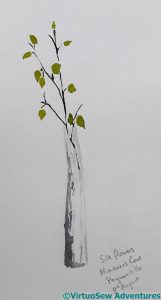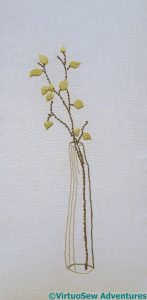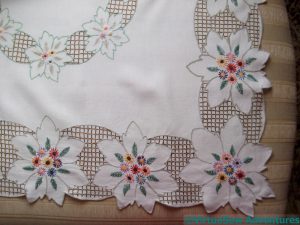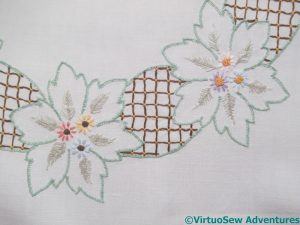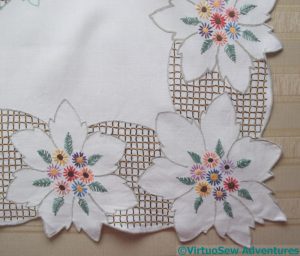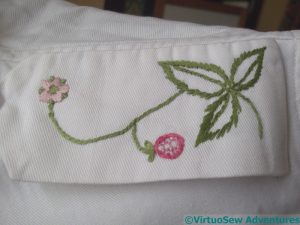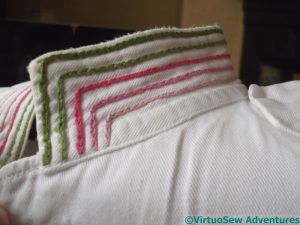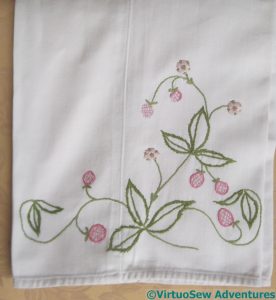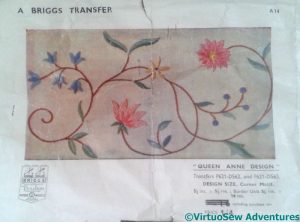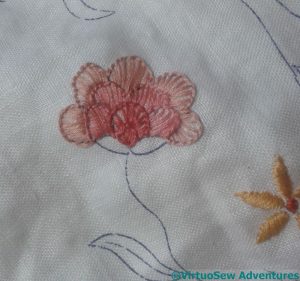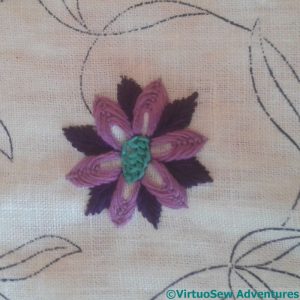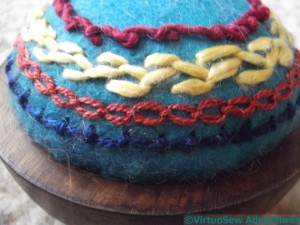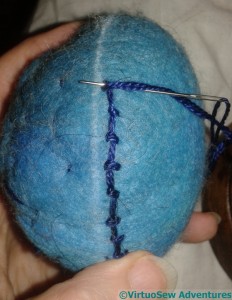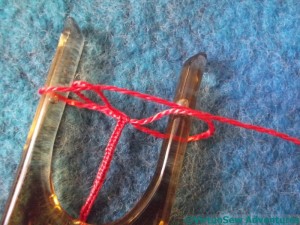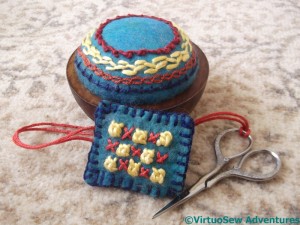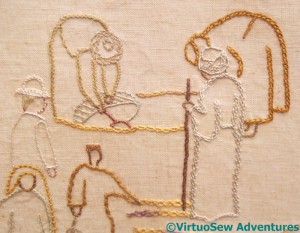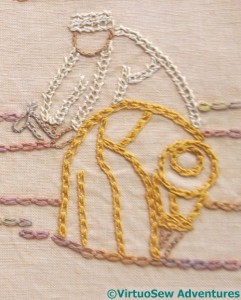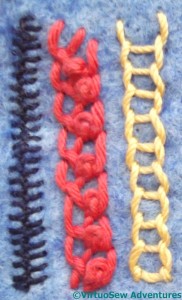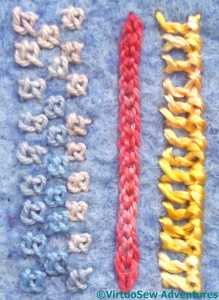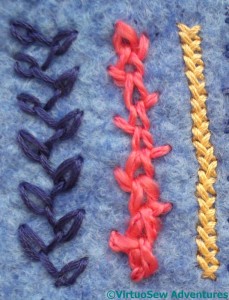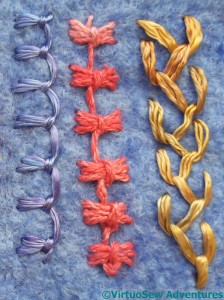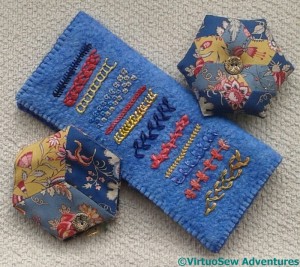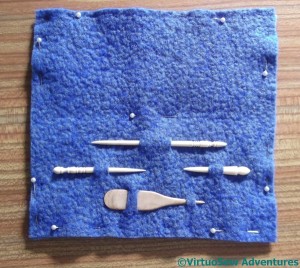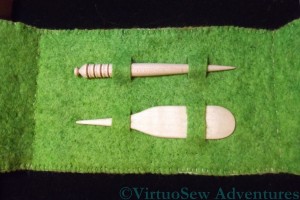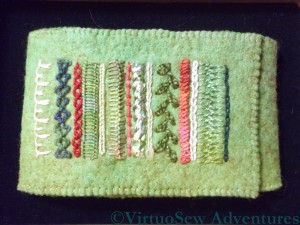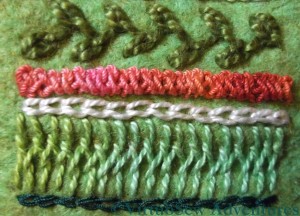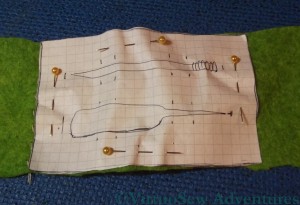Tag: stitches
From Watercolour to Embroidery
This vase of flowers was on the table in a motel room we stayed in, many years ago. For some reason they caught my eye, and for our whole stay – which was full of activity and outings – I wanted to paint them. But we were never in the room for long enough during the daytime.
Finally, on the morning we were going to leave, I got out my paints, sat down, stared very hard, and painted this. I’ve noticed that if I really want to paint something, it often works much better than paintings I’ve done because I want to practise painting.
I don’t think I even bothered to take a photograph. Everything I wanted to remember about the vase is in the painting.
When we got home, however, it seemed to me that the painting offered possibilities as the basis for a simple embroidery.
A very simple embroidery, but, as you see, making use of a variety of stitches.
The vase was textured glass, not clear, and I represented that using lines of coral stitch among the stem stitch. I didn’t work it more densely, because I wanted it to have a certain lightness of touch.
The twigs were very rough and twiggy, so I used scroll stitch.
Finally, the simple shapes of the flowers were best represented using my neatest and most careful satin stitch. All I really wanted from them was the colour.
I haven’t the vaguest idea what to do with the embroidery, so I’ve laced it over a board to keep it tidy. But I thought you might be interested to see one of my very rarest stories – I know other designers often do detailed watercolours of their designs, but it’s not how I work. More often, I have a rough idea in my head, and work on each element while I’m planning the details of the next, waiting for the piece to tell me what it wants.
This has turned out well, but I’m still slightly bewildered that it happened at all!
A Lovely Teacloth
This teacloth was worked by my mother as a schoolgirl.
The design came from a transfer, and there was another girl in her class that was working the same one. With rather a difference. Her flowers were all lazy daisy stitch, and anything else was stem stitch, apart from the edges, and she got the whole thing finished in a term.
Needless to state, as her mother’s daughter, and with the spectre of Miss Hunter in the background, my mother wasn’t going to use a stitch with “lazy” in the name.
She did all the edges in blanket stitch – which with my recent experience with the Azorean Cutwork has me extremely impressed. It takes so long to make any noticeable progress with it!
The leaves are all in feather stitch, and they’re beautifully shaped, and the flowers are satin stitch – very neat satin stitch, which again is one of my least favourite stitches, and one I only do neatly in short bursts and with something else to do in between!
Of course, my mother didn’t get her teacloth done in a single term – but her teacher was so impressed with what was finished that she took it home and handwashed and pressed the completed corner to put in in the end of term exhibition.
In spite of the fact that I very much doubt whether the teacher had contributed anything at all to my mother’s skill in the matter!
Favourite Summer Suit
When the summer comes, some women turn to shorts and vest tops, some go for swishy skirts and gypsy-boho tops. I have a third option – to turn to my grandfather’s old tropical uniforms, which are in lovely sturdy cotton drill softened by all those years of washing, and very nearly indestructible. I’ve dyed two sets, and painted paisley patterns on one of those, but I’m completely outclassed by my mother, who embroidered one set when I was a child.
The designs are based upon very stylised strawberries, strawberry leaves, and flowers. The jacket has short sleeves, epaulettes, and a standing collar, decorated with rows of chain stitch using all the colours used elsewhere in the design. The usual uniform buttons were replaced with vibrant pink mother-of-pearl effect buttons, which make the whole thing markedly more frivolous-looking..
Most of the embroidery is near the hem of the trousers. The strawberries are worked in trellis couching, and the rest of the embroidery is in stem or satin stitch.
I have memories of thinking my Mam looked fabulous in it when I was a child – so much so that I wrestled it from her a few years ago, and feel fabulous myself, every time I wear it.
What I don’t recall is what my Grandfather thought of the transformation…
Something Simple(-ish)
The Azorean Cutwork was not a very successful travelling project, as it needed to be precise, and the poor light of the average hotel-room made precision difficult.
I think this tea-cloth came from the same lady responsible for my fragment of the Quaker Tapestry, and the extra embroidery frames I knew I hadn’t bought. The instructions suggest a welter of unlikely colours and an excess of satin stitch, and I was nearly weak enough for follow them.
Then my mother pointed out that I’ve just done a single-stitch project, and should maybe cut loose a bit.
No sooner suggested than taken up! The wild colours are staying, but the stitchery will be a little more diverse…
After doing yellow satin stitch daisies with orange centres, I used blanket stitch fans for the next flower. I’m sure I’ve seen this before, or used it before, but I can’t remember where!
The design is composed of four corner designs and four straight sections which are all the same. I’m working each bit as I decide on it, rather than working one whole side and then copying it three times. That means that the puzzling and decision making is alternating with the stitching, rather than an orgy of decisions followed by the tedium of doing the same thing over and over and over again.
The purple flower is part of the corner motif, and alternates fishbone stitch (the dark petals) with nested fly stitches. The centre is a circle of blanket stitches with some random interlacing to fill them in.
Worked on a whim
Just before Christmas I was struggling with the “Dreams of Amarna” designs, but I still had itchy fingers from longing to stitch, and sore eyes from staring at “Eve In The Garden of Eden“, so I wanted something a bit less precise..
My Dad’s shaving cream comes in a rather nice wooden pot. There are refills, but sometimes the shop doesn’t have them, and consequently – since they’re much too nice to throw away – my parents have ended up with something of a stockpile. I’ve taken one of them off their hands, and turned it into a pincushion.
At the moment the lid is being used as a coaster, but I am open to suggestions for it!
The threads are silks, bought at the Knitting and Stitching Show, worked on felt acquired at the same time. I created the shape of the pincushion itself with shaping stitches, stitching around and around the padding and the felt top layer, rather as doll and puppet makers do, and once I’d settled it into the bowl, I drew a chalk line around the waist, took the pincushion out, and started stitching.
Coral Stitch, Cable Chain (do I ever do anything that Cable Chain doesn’t sneak into somehow?), Semi-Closed Feather Stitch, and Scroll Stitch, all stitched into the felt, catching as little of the stuffing as I could.
Then I decided to do make a scissors-keeper for my lovely Ernest Wright and Son Ltd scissors, so I started by using one of the threads, and my lucet, to make a cord for it. I’d forgotten some of the knack of lucetting, but it came back gradually, and it’s ever so satisfying!
The stitches on the scissors keeper are Sorbello Stitches (another favourite of mine) and Tied Cross Stitches, and the the pieces of felt are stitched together with ordinary blanket stitch. In silk!
Don’t they look good…!
Still More on the View of the Excavation
As I got nearer the foreground figures, I tried to pick broader stitches, or at least stitches that were a bit more emphatic. This group was great fun to do, starting with the Gufti with his staff of office (Portuguese Knotted Stem!). The Gufti’s robe is Feather stitch, as are some of the twists of his headgear. I concentrated very hard on keeping the stitches even and close so that the “density” of the stitch would be maintained. The one in dark gold is in double interlaced back stitch, except for the top of the headgear, and the waistline – those are whipped backstitch. The other one is in one of the Elizabethan stitches from Jacquie Carey’s book.
I had fun with the supervising excavator – the brim of his solar topee is the Hungarian Braid chain, and I reversed the direction of the chain stitch for the peak of the crown. He’s also the only one with fair hair and pinkish skin, and I dressed him in a pale, tailored jacket.
The two at the front are another mixture of stranded silk, stranded cotton, and round silk thread. The golden veil is coral stitch, and the tunic below it is stranded silk chain stitch, and the dark golden tunic is stranded cotton and twisted chain stitch. I’m trying to make choices of stranded or round yarn that will suit the stitch.
I worked these two diggers on World Embroidery Day – which I hadn’t even known existed until the day before, so I was very glad I was able to sit and stitch!
I went back to my Edith John books for these two. The front one is in Shell Chain stitch, which I first used on the Circle Skirt. I won’t say it’s a favourite, but I have rather taken to it, and it creates an interesting effect.
The one behind is a very peculiar stitch, a combination of twisted chain stitch and open chain stitch. It creates a very square appearance, with the twisted chain alternating from side to side of the open chain, and it is called, rather predictably, Open Twisted Chain Stitch.
Sampler Tool Case – the stitches in the sampler
The whole idea of the sampler on the case is to have a few reminders of stitches I haven’t done before, or use only rarely…
The first row was Fishbone Stitch in navy blue pearl cotton. I wanted something definite to create the edge of the panel. It was a little tricky to stitch on the soft pre-felt, but as I soon remembered – that would be true of all of them!
Next, Mountmellick Thorn Stitch in reddish-pink cotton. I’ve only used this once before, on the Jacobean Work Panel, largely because I have not found a suitable application. I enjoyed it, though, and now the stitch will be before my eyes more regularly, maybe I will find one…
Open Chain Stitch is an awkward stitch. In Barbara Snook’s “Embroidery Stitches”, she says it is best used as the basis for further ornamentation, such as single chain stitches across the bars. and I think you can see why. I used a pale yellow pearl cotton. I like the thread, but the stitch is one that needs more work!
Next, Sorbello Stitch, worked in overdyed blue mercerised cotton. I’ve used this stitch before, to work the modern villages on the Map of Amarna, but at this larger scale the form and texture of the stitch is easier to see.
Hungarian Braided Chain Stitch has become one of my favourite stitches since I used it for the Silken Crane and the Antelope Frieze. This version uses an overdyed pink/red pearl cotton. It does show colour variations nicely!
Bonnet Stitch is a new one for me. I am absolutely sure that yellow rayon is not what the stitch was developed for, but it worked rather well, and I enjoyed it.
I chose Feathered Chain Stitch next because I wanted something fairly wide, and fairly open. The navy stranded cotton makes a strong central axis for the panel.
Petty Chain Stitch is a new one for me. I found it in one of the books by Edith John that I have. She named it after the student who created it by accident when she confused the instructions for two stitches – immortality of a sort, I suppose! I’ve used a pinkish wool slub, doubled to even out the thickness. I’ll try to remember to use this again, in a less textural thread. I think it could prove useful.
The Herringbone Stitch, I chose because I wanted something narrow. You will have noticed I’ve tried to create a rhythm of stitch widths, although it isn’t a repeating pattern as such. The golden pearl cotton has a lovely shine.
Up and Down Buttonhole Stitch is another old friend. The challenge with this blue overdyed rayon floss was not in the stitching, but in wrangling the fifty or so metres that joyously tangled themselves as soon as I untied the skein!
I’ve never used Butterfly Stitch before, either. I’m not sure that the textured pinkish cotton does it the best service, but it creates an interesting effect.
Feather Stitch is harder to stitch well than you might think. The de-twisted gold rayon cord certainly didn’t make life easy, but it helps create an emphatic stop at the end of the panel.
A Sampler Tool Case
Here is something else I completed while I was recovering from Loading The Felucca, pictured with the two gifts from Alison that inspired my colour choices, a pincushion and a needlecase in English Paper Piecing. Considering that I selected my colours from stash, I think they have a surprisingly similar “feel”.
Some of you will recall that a couple of years ago I made a case to hold a wooden stiletto and mellor as a gift for my cousin. I’ve finally got around to making a case for three bone stilettos and a wooden mellor for myself!
I’ve included several stitches I haven’t done before, or use only rarely and I’ll write about those later.
It was a little tricky to find a suitable layout for the tools, but I finally decided I liked this one. I’ve blanket stitched the edges together, now, and I intend to needlefelt the layers together, just as I did with the other one.
When I find my needlefelting tool, which has gone Absent Without Leave!
Making It Up As I Went Along – The Big Reveal
The last time you saw the case I planned for the wooden mellor and stiletto, I’d cut the slits and described how I finished assembling it, using chain stitch down each spine, and blanket stitch around the edge.
When I put the tools in place, though, the whole thing seemed rather flimsy, somehow. I wracked my brains for a bit, and then thought that maybe if I were to needlefelt the layers together, it would give it a little more body.
I have a needlefelting tool with five needles in a single holder, so I fished it out, and stared at it pensively for a while. Fortunately it has a plastic guard around the needles, so I left the tools in place, and needlefelted around them. From both sides.
Then I took out the tools, and felted between the loops so that the fabric behind the tools would stay in place and only the loops themselves would be free of the backing.
Finally, I needlefelted around the edge of the sampler panel and across all of the back, so that the whole case would have the same sense of solidity.
Here is the finished piece. You can zoom in on the picture to get a better view of the stitches, and the needlefelting that gives the piece its body.
I’m very pleased with how it turned out, and I hope my cousin will have many opportunities to use it, and will find the sampler panel inspiring and intriguing.
Making It Up As I Went Along – Part Three
The final set of stitches for the sampler panel starts with Chained Feather Stitch, using very heavy plain pearl cotton
Braid Stitch (number eleven) is another stitch I’m fond of – I used it on the Frolicking Teddies Cot Blanket. It’s a stitch with a huge personality, so it needs to be used with care, but it’s a good one to have in the repertoire. The thread is another overdyed mercerised round yarn, and because braid stitch uses so much thread, it cycles beautifully through the colours and shows them off very well.
Stitch number twelve is Reverse Chain Stitch. This is a stitch I’d never used before the Goldwork Masterclass, but it is a very useful one, because for some threads it is much easier to work than conventional Chain Stitch.
Stitch number thirteen is Cretan Stitch. This is a great border stitch, but because the thread I chose – an overdyed soft cotton – was in a green that was rather close to the colour of the felt, I decided to add a row of Chain stitch in a very dark green silk to define the edge. It balances the cream Up and Down Buttonhole Stitch at the other end beautifully.
I double checked that I was happy with the layout for the tools by pinning an outline of the two wooden tools onto the felt.Since I used squared paper for the templates it was also very easy to plan where I would place the slits that would allow to tools to be held in place, and to line them up properly.
Then all I had to do was to make use of my mother’s buttonhole cutter to cut the slits – straight through the paper template – and reassemble the two layers. That was harder than I expected. I’d forgotten that felt is a very flexible material, and it bent and stretched itself, and needed to be coaxed back into shape, and then pinned firmly back into stability. Then I chain stitched down each spine, and blanket stitched around the edge….

